

SIGNS IN THE SKY
12-12-09
BLUE BEAM SPIRAL IN THE SKY
NORWAY
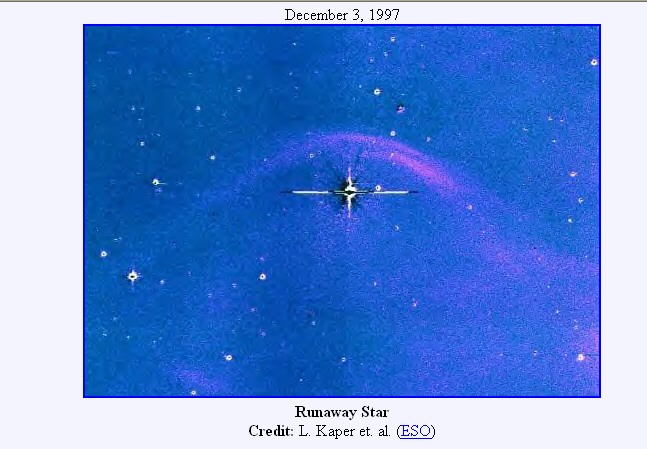
Runaway stars are massive stars traveling rapidly through interstellar space. Like a ship plowing through the interstellar medium, runaway star HD 77581 has produced this graceful arcing bow wave or "bow shock" - compressing the gaseous material in its path. Located near the centre of this European Southern Observatory photograph, HD 77581 itself is so bright that it saturates the sensitive camera and produces the spiky cross shape. This star is over 6,000 light-years away in the constellation Vela, and appears to move at over 50 miles per second. What force could set this star in motion? A clue to the answer may lie in its optically invisible companion star, an X-ray bright pulsar known as Vela X-1. This pulsar is clearly the remnant of a supernova explosion ... which seems to have given this massive star and its companion a mighty kick!
| From the editor: We think it is possible that the following news is connected to a recent report received (also classified at this time) that an object 15 to 20 miles wide is reading towards earth. It can't be an asteroid or comet we don't think because it's trajectory and speed keeps changing. Many scientists are heading for the antarctic to take a look at it through their telescopes there as it is coming from the direction of the southern hemisphere.
For 15 years, scientists have benefited from data gleaned by U.S. classified satellites of natural fireball events in Earth's atmosphere – but no longer. A recent U.S. military policy decision now explicitly states that observations by hush-hush government spacecraft of incoming bolides and fireballs are classified secret and are not to be released, SPACE.com has learned.The satellites' main objectives include detecting nuclear bomb tests, and their characterizations of asteroids and lesser meteoroids as they crash through the atmosphere has been a byproduct data bonanza for scientists.The upshot: Space rocks that explode in the atmosphere are now classified."It's baffling to us why this would suddenly change," said one scientist familiar with the work. "It's unfortunate because there was this great synergy...a very good cooperative arrangement. Systems were put into dual-use mode where a lot of science was getting done that couldn't be done any other way. It's a regrettable change in policy." Scientists say not only will research into the threat from space be hampered, but public understanding of sometimes dramatic sky explosions will be diminished, perhaps leading to hype and fear of the unknown.Incoming! Most "shooting stars" are caused by natural space debris no larger than peas. But routinely, rocks as big as basketballs and even small cars crash into the atmosphere. Most vaporize or explode on the way in, but some reach the surface or explode above the surface. Understandably, scientists want to know about these events so they can better predict the risk here on Earth.Yet because the world is two-thirds ocean, most incoming objects aren't visible to observers on the ground. Many other incoming space rocks go unnoticed because daylight drowns them out. Over the last decade or so, hundreds of these events have been spotted by the classified satellites. Priceless observational information derived from the spacecraft were made quickly available, giving researchers such insights as time, a location, height above the surface, as well as light-curves to help pin down the amount of energy churned out from the fireballs. And in the shaky world we now live, it's nice to know that a sky-high detonation is natural versus a nuclear weapon blast. Where the space-based surveillance truly shines is over remote stretches of ocean – far away from the prospect of ground-based data collection. But all that ended within the last few months, leaving scientists blind-sided and miffed by the shift in policy. The hope is that the policy decision will be revisited and overturned. Critical importance "The fireball data from military or surveillance assets have been of critical importance for assessing the impact hazard," said David Morrison, a Near Earth Object (NEO) scientist at NASA's Ames Research Center. He noted that his views are his own, not as a NASA spokesperson. The size of the average largest atmospheric impact from small asteroids is a key piece of experimental data to anchor the low-energy end of the power-law distribution of impactors, from asteroids greater than 6 miles (10 kilometers) in diameter down to the meter scale, Morrison told SPACE.com. "These fireball data together with astronomical observations of
larger near-Earth asteroids define the nature of the impact hazard and
allow rational planning to deal with this issue," Morrison said. As example, the fireball data together with infrasound allowed scientists to verify the approximate size and energy of the unique Carancas impact in the Altiplano -- on the Peru-Bolivia border -- on Sept. 15, 2007. Fireball information also played an important part in the story of the small asteroid 2008 TC3, Morrison said. That was the first-ever case of the astronomical detection of a small asteroid before it hit last year. The fireball data were key for locating the impact point and the subsequent recovery of fragments from this impact.Link in public understanding Astronomers are closing in on a years-long effort to find most of the potentially devastating large asteroids in our neck of the cosmic woods, those that could cause widespread regional or global devastation. Now they plan to look for the smaller stuff. So it is ironic that the availability of these fireball data should be curtailed just at the time the NEO program is moving toward surveying the small impactors that are most likely to be picked up in the fireball monitoring program, Morrision said. "These data have been available to the scientific community for the past decade," he said. "It is unfortunate this information is shut off just when it is becoming more valuable to the community interested in characterizing near Earth asteroids and protecting our planet from asteroid impacts." The newly issued policy edict by the U.S. military of reporting fireball observations from satellites also caught the attention of Clark Chapman, a planetary scientist and asteroid impact expert at Southwest Research Institute in Boulder, Colorado. "I think that this information is very important to make public," Chapman told SPACE.com. "More important than the scientific value, I think, is that these rare, bright fireballs provide a link in public understanding to the asteroid impact hazard posed by still larger and less frequent asteroids," Chapman explained. Those objects are witnessed by unsuspecting people in far-flung places, Chapman said, often generating incorrect and exaggerated reports."The grounding achieved by associating these reports by untrained observers with the satellite measurements is very useful for calibrating the observer reports and closing the loop with folks who think they have seen something mysterious and extraordinary," Chapman said. Leonard David has been reporting on the space industry for more than four decades. He is past editor-in-chief of the National Space Society's Ad Astra and Space World magazines and has written for SPACE.com since 1999.
|
|
| 7-23-09 - No sunspots today
AURORA
SURPRISE:
Sometimes the auroras are
so bright, you just can't sleep. "I was up all night on July
21st, but it was totally worth it!" says photographer Zoltan
Kenwell of Chip Lake, Alberta. This is what kept him awake:
"It was a very impressive show that lasted 4.5 hours!" says Kenwell. Forecasters did not predict this display. It began on when a seemingly minor solar wind stream hit Earth's magnetic field. The minor hit turned into a not-so-minor display because a crack opened in Earth's magnetic field, allowing solar wind to pour in and fuel the storm. Northern Lights descended as far south as the Dakotas, Montana, Iowa and Wisconsin. The solar wind is still blowing, but the crack has closed, bringing an end to the lights. Until next time, browse the gallery: UPDATED:
July 2009 Aurora Gallery TOTAL SOLAR ECLIPSE: Chasing an eclipse can be a nerve-wracking experience. Just ask Alan Dyer, who on July 21st was sailing through the path of totality in the south Pacific Ocean when clouds began to gather overhead. "The early, partial stages of the eclipse were blocked," says Dyer. "We had to chase into a clear hole to catch this view of totality." "The sight of the low-hanging Sun in eclipse was spectacular with an impressively large Sun/Moon disk caused by the 'moon illusion' effect," he says. "In the end, we were a happy ship of 300 eclipse chasers!"
|
|
|
7-22-09
Eclipse 7-22-09 TOTAL ECLIPSE: On Wednesday, July 22nd, the Moon eclipsed the midday sun over China. "The temperature dropped from 96.6 F to 88.5F at totality," reports Donald Gardner from Huangshan. "The roosters were crowing and the streetlights came on!" He took this picture of a sun-sliver beaming through lunar mountains:
Browse the gallery for more scenes from the path of totality:
UPDATED:
July 22nd Eclipse Gallery
"These are the first auroras I have been able to photograph in more than a year," says Tenho Tuomi. "It was a pleasant surprise." The display was sparked by a solar wind stream which hit Earth's magnetic field on July 21st. The ensuing geomagnetic storm registered 6 on the 0 to 9 K-index scale of geomagnetic activity. "My magnetometer picked up the disturbance and I rushed outside to see the show," says Tuomi. July 2009 Northern Lights Gallery
|
|
7-18-09 - DID WE? or DID WE NOT GO TO THE MOON?
ASTRONOMY
DREAM
AND NOSTRADAMUS CONNECTIONS
TO THE
OBJECT NEAR THE HALE BOPP COMET PART I
HALE BOPP AND
AND NOSTRADAMUS CONNECTIONS
TO THE OBJECT NEAR THE HALE BOPP COMET - PART II
DREAM
AND NOSTRADAMUS CONNECTIONS
TO THE
OBJECT NEAR THE HALE BOPP COMET - PART III

.
.
.
.
.
SHORTCUT TO ALPHABETICAL LISTING AT BOTTOM OF PAGE
BUT DON'T MISS THE BIG ONES LISTED FIRST!
A, B, C, D, E, F, G, H, I, J, K, L, M, N, O, P, Q, R, S, T, U, V, W, X, Y, Z, WEATHER.
ASTEROID EROS BEING ORBITED BY SATELLITE NEAR
CLEMENTINE CD ROMS - IMAGES AT NSSDC

| EARTHVIEW ECLIPSE NETWORK | 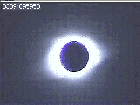 |
| Eclipse - March 9, 1997 |
ALL ABOUT THE 1999 ECLIPSE
AND KING ARTHUR AND THE HOLY GRAIL
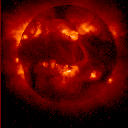
PLANETARY ANOMALIES - THE MARS/MOON/ANCIENT SITES CONNECTIONS |
NEPTUNE MOVES INTO AQUARIUS JANUARY 29, 1998
PLANETARY ALIGNMENT - 5-5-2000

REAL TIME SPACE WEATHER DATA RESOURCES
SPACE WEATHER - A RESEARCH PERSPECTIVE
STAR OF BETHLEHEM AND THE CAPSTONE AT GIZA PYRAMID
SUN AND PLANET ALIGNMENT - 5-5-2000
THE DOG STAR
SIRIUS A AND SIRIUS B
THE SOHO CORONAL DIAGNOSTIC SPECTROMETER
THE SOLAR AND HELIOSPHERIC OBSERVATORY
Stockholm Observatory
NASA Television on CUSEEME
NASA Shuttle Web
Live Images from NASA TV
VIEWS OF THE SOLAR SYSTEM
SPANISH AND PORTUGUESE
VIRTUAL REALITY MOON PHASE PICTURES
WHATS THE BIG DEAL WITH 19.5 AND 33?
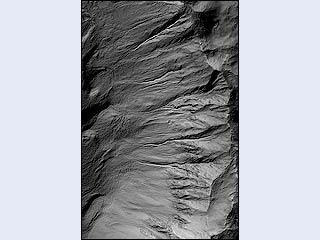 |
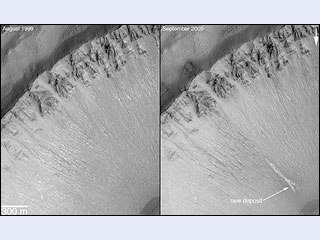 |
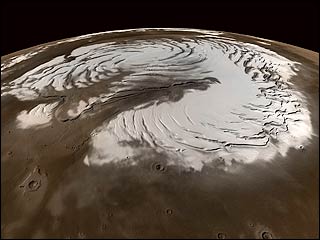 |
|
|
Images released Wednesday show a new gully deposit in a Martian
crater. The photo is from 1999. The one at right, taken in 2005, shows a light-toned deposit. |
Global Surveyor took this image of Mars in 2001. Other studies have suggested water may flow briefly on the surface, possibly from underground. Source: AP |
These are sites for those who want to check the weather before doing any observing.
If you would like to ask questions, make comments, or add a link to this page, please e-mail to: dee777@aol.com